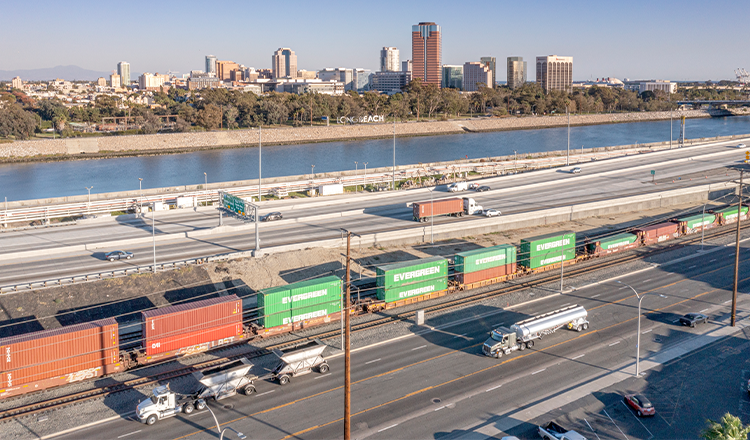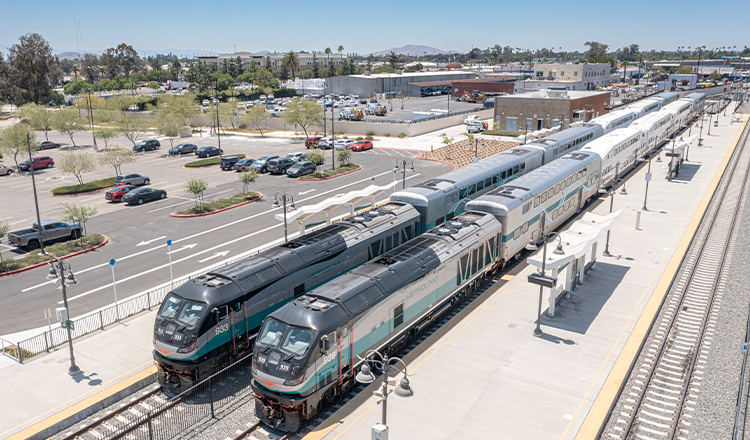
Experts Talk: Power Optimization to Prepare for Zero Emissions Rail Vehicle Technology With Marcin Taraszkiewicz
Experts Talk is an interview series with technical leaders from across our transportation program.
How To Reduce Power Use Today to Be Ready for a Carbon Reduction Future
The zero emissions renaissance has emerged within the rail industry, and the result is a massive shift in how rail companies are looking ahead how they plan to operate. Electric and hydrogen-fueled trains are rapidly arriving in the market — with organizations like the San Bernardino County Transportation Authority launching their first zero emissions pilot trains in the United States, with service beginning in 2025. Investments in the shift to zero emissions technologies are requiring companies to rethink how to approach assets, like rail vehicles, which are intended to run in-service decades. As rail organizations prepare for these new technologies, they can begin to remove one potential barrier: Power usage. Many zero emissions technologies require vastly more power than legacy systems. Optimizing power usage now can help prepare for the shift toward future technologies — while at the same time saving on costs in the present.
Our Rail Vehicle Technology Lead, Marcin Taraszkiewicz, has more than three decades of experience working with locomotives. He is a foremost expert in rail vehicle technology and specializes in implementing new zero emissions solutions. Marcin has helped rail operators across the U.S. navigate the new path forward, balancing lofty decarbonization goals with the return on investment and technological limitations. In this interview, he shares how owners and operators can prepare for a zero emissions future.
Q. Why should owners and operators optimize power use?
A. There are two main reasons why optimizing power use is important. From a most basic perspective, optimizing power use leads to lower energy usage, which reduces energy costs. But reducing energy consumption can also have a positive impact on the environment if the sources of energy are not emission free. With diesel locomotives, this is easy to see as less fuel use will yield less greenhouse gases being released. However, using other power sources, such as electricity or hydrogen, more efficiently can also have a positive environmental impact as much of those power sources are still being produced using processes that produce greenhouse gases as a byproduct.
The second benefit of optimizing energy use is that more efficient use of energy today could yield a wider set of options for conversion to zero emission energy sources in the future. Current sources of zero emission propulsions, namely batteries and hydrogen, both have a lower energy density per volume than an equivalent volume of diesel fuel. This means that to replace a diesel engine with a zero emission power source, much more space is required to store that energy source. In some cases, more energy needs to be stored than can be reasonably accommodated in and existing rail vehicle design. However, if energy use on existing vehicles can be optimized so that less energy is needed to achieve the same operating goals, then the space required to store on-board energy can be reduced, thus potentially yielding more option for zero emission power conversion.

Q. What are strategies to reduce equipment energy use on locomotives?
A. One approach to reduce energy use on locomotives is to add battery storage to support the recovery of braking energy, thus creating a hybrid propulsion system. Locomotive hauled trains need to dissipate a large amount of energy during braking, and a hybrid propulsion system allows energy to be recovered during the braking process and used later to accelerate the train. This is the same approach used on hybrid road vehicles. A recent paper, co-authored by our Michael Copley, found that on some routes, this approach saved up to 25% in fuel consumption.
Other strategies involve a proactive approach to the maintenance of existing equipment and assets. Multiple agencies are currently actively monitoring and eliminating air leaks from the train air system, which reduces the amount of power required to maintain air pressure in the trainlines. The elimination of air leaks reduced the amount of power required to maintain air pressure in the trainlines. Some studies have shown that eliminating leaks can reduce fuel burn by as much as 60% when idling and by 5% or more when operating in service.
The management of wheel/rail interfaces and friction in curves reduces the friction generated between the wheels and rail, thus reducing the power required to move the train. The resistance force between the wheel and rail in a curve generally equals 0.8 lb. per ton per degree of curvature. This does not sound like a lot but adds up quickly, especially for long and heavy freight trains. Studies have shown that rail lubrication in curves can reduce fuel consumption through a curve by between 5% and 13%, depending on rail conditions and curve characteristics. On lines with many curves, this could have a significant impact on fuel consumption.
Q. How about operations, how can energy be reduced there?
A. Efficient train handling and acceleration can yield significant savings. Each acceleration uses more fuel. Accelerating fast uses more fuel than a smooth and even acceleration. The faster you go, the more energy you consume. For example, what is the cost-benefit of an agency considering increased train speed from 79 to 110 miles per hour? Software can help answer that question and provide opportunities to optimize efficiency.
Several rail operators are also running trials with trip optimizer software, which can calculate the most energy efficient approach for traversing a given train route. By managing parameters such as train speed, acceleration, and tractive effort in multiple locomotive trains relative to the train location along its route, this software ensures that the train is always operating at optimal levels to minimize energy use while meeting operating schedule needs. Some operators report savings of up to 1.4 gallons of diesel fuel per mile of operation on certain routes operated in this way.
Q. How are federal and state regulations affecting this?
A. The Federal Railroad Administration is working to establish a process by which alternative technologies can be evaluated for approval to compliantly operate within regulatory requirements. They’ve set out some initial guidance on this topic and have been working on broadening that guidance to cover the available decarbonization technologies.
A key consideration when assessing the pros and cons of vehicle transition is safety. The regulatory process relies heavily on a robust safety analysis. The FRA remains open to all fleet decarbonization options — as long as the option maintains the same level of safety as the diesel operation.
There is funding available now to advance rail decarbonization. There are research grants for trial or test runs that will benefit the industry as a whole. There’s also federal funding to upgrade locomotives. It’s important to consider the conditions, however — some grants require a 1:1 replacement of diesel vehicles with zero emissions vehicles, which is not feasible for every situation.

Q. With technology changing so fast, how can rail owners/operators prepare for what’s coming?
A. It’s important to note that the existing rail vehicle zero emissions technology is limited for long-haul operations. Some equipment we’re buying today will likely be obsolete 10 years from now. But diesel trains need to be replaced now, so owners are currently in a place where they need to implement interim solutions.
The power requirements for local, short-distance passenger trains in the U.S. can make do with the existing zero emissions technology, like San Bernardino is doing. However, long-haul locomotives for freight operations, and even long-distance passenger routes, do not currently have a reasonably mature solution for a viable replacement to diesel.
Investments in relatively new diesel locomotives will need to continue, consistent with asset management plans. Fleet planning becomes key — understanding the mix of older versus newer locomotives and how many will need to be replaced in five, 10 or 20 years.
The update of fleet plans should include the analysis of the fleet’s current status, current utilization, and future service plans. As older locomotives are replaced, new electric or hydrogen trains can run on shorter routes. Newer diesel locomotives can be put on longer routes. By the time those diesel locomotives are reaching the end of their service life, the technology should have matured and we hopefully will have more answers and options.
Right now, a good interim solution is some sort of a biofuel or synthetic fuel. They deliver roughly the same amount of energy that diesel does but with far less greenhouse gas emissions. These also require fewer modifications than either battery or hydrogen vehicles. Another good approach is a hybrid solution, using batteries to store energy dissipated during braking and using that energy to augment a diesel engine’s output during acceleration.
Inspiration & Advice
Q. How did you get into the zero emissions rail vehicle field?
A. It was thanks to my work at the San Bernardino County Transportation Authority. I was working on their diesel multiple unit trains. SBCTA was really interested in being the first in the U.S. to pilot a zero emissions vehicle. They brought me in as the person who has expertise with the other 85% of the vehicle that wasn’t changing.
Very soon when we started this project I found myself really focusing on that other 15%. At the time, the technology was really new. It became a very exciting process where we were learning a lot about this technology very quickly by asking questions. If we didn’t have an answer, we’d have to go investigate.
That process of inquiry, looking at what we have, considering all the things that go wrong or can be optimized, ended up yielding us a design of a real train you can touch and ride.
Zero emissions gave me the opportunity to look at new radical solutions for this issue of decarbonization while at the same time maintaining the same level of service. It’s allowed me to think outside the box, that’s what makes it exciting.
Q. Do you have any advice for people just starting out in the field?
A. Imagination and an open mind have been my biggest assets. Because this is so new, moving to zero emission propulsion requires you to think very differently about railroading in general. For decades most of us had a certain preconception of how railroad vehicles are built and operated, but now we’re finding that those approaches might not be a match for the way that this new technology works. You need that open mind and imagination to come up with innovative solutions to integrate into current and future operations plans.
Each Experts Talk interview illuminates a different aspect of transportation infrastructure planning, design and delivery. Check back regularly to discover new insights from the specialized experts and thought leaders behind our award-winning, full service consulting practice.




